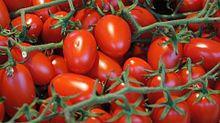| Revision as of 01:53, 11 June 2010 editVisik (talk | contribs)Autopatrolled, Extended confirmed users, Pending changes reviewers, Rollbackers30,404 edits →External links← Previous edit | Latest revision as of 01:14, 16 December 2024 edit undoSarsenet (talk | contribs)453 edits added stub templates | ||
| (42 intermediate revisions by 38 users not shown) | |||
| Line 1: | Line 1: | ||
| {{Short description|Class of tomatoes}} | |||
| ] | |||
| {{Primary sources|date=March 2011}} | |||
| ] | |||
| ] | |||
| ] | |||
| ] | |||
| ⚫ | A '''grape tomato''' is a class of tomatoes |
||
| ]]] | |||
| ] | |||
| ⚫ | A '''grape tomato''' is a class of tomatoes believed to be of southeast Asian origin, shaped similarly to the oval ]es but having the small size and sweetness of ]es. Grape tomatoes produce small and typically oblong fruits. Introduced to the worldwide market in the 1990s, they have gained substantial popularity, due at least in part to their higher sugar content compared to regular tomatoes, and due to their smaller, bite-sized shape.<ref>{{cite news|url=https://www.washingtonpost.com/archive/lifestyle/food/2001/09/12/attack-of-the-grape-tomatoes/f568663b-148f-4625-8342-6f9ba930b753/|title=Attack of the Grape Tomatoes|date=2001-09-12 |work=Washington Post |location=Washington |access-date=2021-04-17}}</ref> | ||
| A commercially significant variety, the "Santa F1", was introduced into the United States market in 1997 by grower Andrew Chu, who obtained the seeds from ]'s Known-You Seed Company. Procacci Brothers Sales Corporation (PBSC) in Philadelphia acquired global exclusivity of this fruit and has aggressively marketed it under its subsidiary Santa Sweets, Inc. | |||
| ] | |||
| ⚫ | The Santa F1 variety is rare in seed form, being offered only by a few seed houses around the world (the United Kingdom's ] has sporadically featured the variety in its catalog from time to time); some gardeners report the seed can breed true out to six or more generations, an assertion that has received little notice from most gardening authorities. Other grape tomato cultivars, such as Rosalita, are more widely available to home gardeners. | ||
| == References == | |||
| ⚫ | The Santa F1 variety is |
||
| <references/> | |||
| ==See also== | ==See also== | ||
| * ] | * ] | ||
| {{Tomatoes}} | |||
| ==External links== | |||
| * | |||
| * | |||
| * Article from the Washington Post | |||
| * does not seem to be a live page as of May 2007, but still accessible from Google | |||
| ] | ] | ||
| ] | |||
| ] | |||
| {{Fruit-stub}} | |||
| {{Solanales-stub}} | |||
| {{vegetable-stub}} | |||
Latest revision as of 01:14, 16 December 2024
Class of tomatoes| This article relies excessively on references to primary sources. Please improve this article by adding secondary or tertiary sources. Find sources: "Grape tomato" – news · newspapers · books · scholar · JSTOR (March 2011) (Learn how and when to remove this message) |




A grape tomato is a class of tomatoes believed to be of southeast Asian origin, shaped similarly to the oval plum tomatoes but having the small size and sweetness of cherry tomatoes. Grape tomatoes produce small and typically oblong fruits. Introduced to the worldwide market in the 1990s, they have gained substantial popularity, due at least in part to their higher sugar content compared to regular tomatoes, and due to their smaller, bite-sized shape.
A commercially significant variety, the "Santa F1", was introduced into the United States market in 1997 by grower Andrew Chu, who obtained the seeds from Taiwan's Known-You Seed Company. Procacci Brothers Sales Corporation (PBSC) in Philadelphia acquired global exclusivity of this fruit and has aggressively marketed it under its subsidiary Santa Sweets, Inc.

The Santa F1 variety is rare in seed form, being offered only by a few seed houses around the world (the United Kingdom's Thompson & Morgan has sporadically featured the variety in its catalog from time to time); some gardeners report the seed can breed true out to six or more generations, an assertion that has received little notice from most gardening authorities. Other grape tomato cultivars, such as Rosalita, are more widely available to home gardeners.
References
- "Attack of the Grape Tomatoes". Washington Post. Washington. 2001-09-12. Retrieved 2021-04-17.
See also
This fruit-related article is a stub. You can help Misplaced Pages by expanding it. |
This Solanales article is a stub. You can help Misplaced Pages by expanding it. |
This vegetable-related article is a stub. You can help Misplaced Pages by expanding it. |